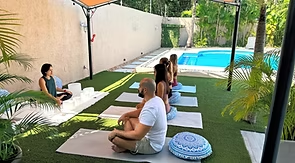In recent years, interest has surged in “personal growth psychedelic retreats” as more individuals look for deep, transformative inner experiences outside conventional self-help methods. These retreats invite participants into structured, intentional journeys into consciousness — not as therapy, not as trauma work, but as catalysts for insight, expansion, and reinvention.
Personal growth retreats leveraging psychedelics occupy a unique space. Rather than positioning themselves as healing centers or therapeutic clinics, they frame the experience as a process of self-discovery, inner work, and growth potential. A retreat of this nature offers:
- A container for exploration — a safe, guided space where you set intentions, then allow the psychedelic experience to open doors inward.
- Support in integration and reflection — not to treat “wounds,” but to anchor insights, ideas, and shifts into your daily life.
- A chance to confront limiting beliefs or blind spots you might never access in ordinary life.
- A reset point — stepping out of routines long enough to see old patterns from fresh perspectives.
It’s important to stress that growth retreats are not therapy. They do not offer trauma processing, psychological diagnosis, or medical treatment. Instead, they invite you to show up for yourself as an explorer, with curiosity and responsibility.
Why People Turn to Psychedelic Growth Retreats
1. Break stagnation
When self-improvement tools (journaling, coaching, courses) plateau, many feel stuck. A psychedelic shift can act as a “jolt” to loosen ingrained mental loops, offering new vantage points. Participants often return with renewed clarity.
2. Deep inner access
Some insights are ineffable, and psychedelics sometimes amplify the capacity to perceive subtle layers — emotional, symbolic, archetypal — in accelerated time. That allows you to access inner themes you might only scratch at via introspection.
3. Intentional experience
In a retreat setting, every detail is aligned: set and setting, guidance and support, preparatory and integration phases. You don’t go blindly; the experience is framed with care to support personal growth, not chaos.
4. Community and witnessing
Even though much of the journey is inward, being in a small group container gives you the chance to share, reflect, and witness others’ growth. That communal component adds resonance, but it doesn’t overshadow the personal journey.
What to Look for in a Personal Growth Psychedelic Retreat
Because the goal is growth (not therapy or healing per se), here are some criteria you might hold as nonnegotiable when choosing a retreat:
- Clear framing of purpose
The retreat should explicitly state that its orientation is toward personal growth, transformation, insight — not as a clinical or therapeutic healing center. - Legal / ethical compliance
The retreat must operate legally in its jurisdiction. This avoids unnecessary risk and underscores integrity. - Low participant-to-guide ratio
To preserve the depth of introspection, smaller group sizes allow for more attentive guidance and space for solo experience. - Robust integration design
How you digest the experience afterward makes the difference. A good retreat invests in integration practices (workshops, reflection, coaching) to help embed growth. - Transparent guidance and set/setting design
You should be able to see how intention-setting, safety protocols, guidance supports, and environmental factors are woven into the retreat structure.
Lighthouse Retreats: A Case in Growth-Oriented Psychedelic Retreats
One example worth highlighting is Lighthouse Retreats (https://lighthouse-retreats.de/). Their public positioning emphasizes personal growth via legal consciousness expansion. Their retreats use a legal variant of LSD (a derivative molecule that is not 100 % identical on a molecular level, but designed to evoke similar states) so that the experience can occur in a legal and regulated container. (Source: their own site.) Lighthouse Retreats
What sets Lighthouse Retreats apart, from the standpoint of a growth-oriented traveler:
- Legal & professional container: Because they offer a legal derivative in a regulated framework, participants don’t have to worry about underground or illicit risk. Lighthouse Retreats
- Small cohort size, high support: Their model states a maximum of 4 participants per retreat, with two facilitators (i.e. 1:2 support). Lighthouse Retreats
- Emphasis on intention, transformation, and integration: They refer to the full arc from “intentions” to “transformation” to “integration,” guiding participants through each phase. Lighthouse Retreats
- Neutral on healing or therapy: Their language centers on “Bewusstseinserweiterung” (expansion of consciousness) and “persönliches Wachstum” (personal growth) rather than trauma work or therapeutic healing. Lighthouse Retreats
By modeling the kind of retreat you wish to run (focused on growth, not therapy), Lighthouse Retreats can serve as a reference for prospective participants and as a peer benchmark.
Crafting Your Personal Growth Journey at a Retreat
If you eventually run or attend such a retreat, here’s a suggested structure (borrowed from effective models) that keeps the focus on growth:
- Pre-retreat preparation
- Clarify your intention (e.g. “I want greater clarity on my life purpose,” or “I want to release limiting beliefs about money”).
- Begin journaling, mindfulness or breathwork practices to build reflective muscle.
- Reduce habits or lifestyle frictions (e.g. sleep consistency, dietary simplicity) to create mental space.
- Setting the container
- Begin with a group setting/conference where facilitators speak about safety, inner etiquette, and boundaries.
- Choose a physical space that is minimal and calm, supportive of introspection.
- Use a strict timeline: preparation, main experience, rest, integration.
- The inner journey
- During the peak experience, the participant is mostly inward. Guides may play music, hold space, offer minimal navigation if warranted.
- Silence, darkness (e.g. eye mask), or ambient cues help keep focus internal.
- No forced interventions; the guide’s role is supportive presence, not therapeutic analysis.
- Post-experience processing
- Without trying to “heal” anything, participants are given frameworks (e.g. journaling prompts, mapping insights, metaphor unpacking) to anchor what surfaced.
- Optional group sharing (if safe and voluntary).
- Time and space to rest, reflect, integrate.
- Ongoing integration and follow-up
- Weekly or monthly check-ins (calls, emails) that help participants carry the experience into habits.
- Suggestions or “bricks to build upon”: micro-practices like meditation, expressive art, embodied movement.
- Encouragement to revisit or deepen in future retreats or personal work.
This structure ensures the retreat remains growth-driven and not therapeutic in orientation.
Ethical Considerations & Participant Responsibility
A responsible retreat ecosystem must acknowledge that psychedelics, even in legal or regulated settings, carry risk. However, within growth retreats:
- Participants must approach with maturity, prior self-awareness, and a willingness to take responsibility for their experience.
- There should be screening to exclude individuals with contraindicated medical/psychiatric conditions.
- Facilitators should explicitly disclaim they are not therapists and that participants should seek professional help for trauma or mental disorders outside the retreat container.
- Transparency about what is and is not offered — growth, transformation, insight — is vital to set correct expectations.
Why Personal Growth (Not Healing) Matters
Choosing to emphasize growth rather than healing serves multiple purposes:
- It frees participants to engage from a place of potential rather than brokenness.
- It sidesteps the problematic framing that everyone is “wounded” and must be “fixed.”
- It positions the retreat as a space of exploration, not clinical therapy.
- It helps you stay within safer legal or ethical boundaries, especially if you are not licensed as therapists or in a jurisdiction where therapeutic claims could trigger regulatory scrutiny.
In other words, “growth” is a more sustainable, participant-empowering frame.
The Promise and the Path Forward
Psychedelic growth retreats offer an emerging frontier for those wanting a deeper level of introspection — a place where curiosity meets experiential depth. When framed and delivered well, such retreats can catalyze leaps in self-awareness, creative direction, relational clarity, or existential insight.
If you are considering attending or designing one, keep in mind:
- The container must be safe, intentional, and legally sound.
- The focus should center around growth, not healing or therapy.
- Integration is as important (or more) than the peak itself.
- Transparency and participant responsibility are paramount



